
Transport in Greece has undergone significant changes in the past two decades, vastly modernizing the country's infrastructure and transportation. Although ferry transport between islands remains the prominent method of transport between the nation's islands, improvements to the road infrastructure, rail, urban transport, and airports have all led to a vast improvement in transportation. These upgrades have played a key role in supporting Greece's economy, which in the past decade has come to rely heavily on the construction industry.
Transport in Iraq consists of railways, highways, waterways, pipelines, ports and harbors, marines and airports.
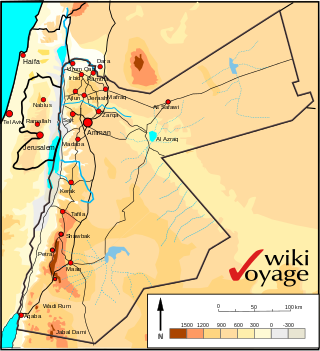
Jordan is situated geographically in Southwest Asia, south of Syria, west of Iraq, northwest of Saudi Arabia, east of State of Palestine. The area is also referred to as the Middle or Near East. The territory of Jordan now covers about 91,880 square kilometres (35,480 sq mi).

Transport in Syria is possible by rail, road, air or rivers, both public and private. Syria is a developed Asian country with a well-developed rail network (2,052 km) and a highway system (782 km). Main international airport is the Damascus International Airport in the capital, Damascus.

As a direct consequence of the country's poverty, Yemen compares unfavorably with its Middle Eastern neighbors in terms of transportation infrastructure and communications network. The roads are generally poor, although several projects are planned to upgrade the system. There is no rail network, efforts to upgrade airport facilities have languished, and telephone and Internet usage and capabilities are limited. The Port of Aden has shown a promising recovery from a 2002 attack; container throughput increased significantly in 2004 and 2005. However, the expected imposition of higher insurance premiums for shippers in 2006 may result in reduced future throughput. The announcement in summer 2005 that the port's main facility, Aden Container Terminal, would for the next 30 or more years be run by Dubai Ports International brings with it the prospect of future expansion.

The Gulf of Aqaba or Gulf of Eilat is a large gulf at the northern tip of the Red Sea, east of the Sinai Peninsula and west of the Arabian Peninsula. Its coastline is divided among four countries: Egypt, Israel, Jordan, and Saudi Arabia.

Aqaba is the only coastal city in Jordan and the largest and most populous city on the Gulf of Aqaba. Situated in southernmost Jordan, Aqaba is the administrative center of the Aqaba Governorate. The city had a population of 148,398 in 2015 and a land area of 375 square kilometres (144.8 sq mi). Today, Aqaba plays a major role in the development of the Jordanian economy, through the vibrant trade and tourism sectors. The Port of Aqaba also serves other countries in the region.

Zarqa is the capital of Zarqa Governorate in Jordan. Its name means "the blue (city)". It had a population of 635,160 inhabitants in 2015, and is the most populous city in Jordan after Amman.

Aqaba Airport ❲also known as King Hussein Int'l Airport ❳ is an airport located in the vicinity of Industrial City, northern suburb of Aqaba in Jordan.
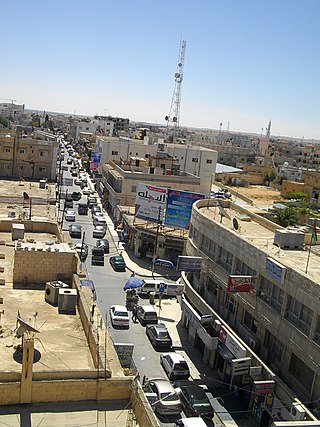
Mafraq is the capital city of Mafraq Governorate in Jordan, located 80 km to the north of the national capital, Amman. It is located at a crossroads, with a road north going to Syria and another road to the east going to Iraq. It had 56,340 inhabitants in 2004.

Aqaba is one of the governorates of Jordan, located south of Amman, capital of Jordan. Its capital is Aqaba. It is the fourth largest governorate in Jordan by area and is ranked 10th by population.
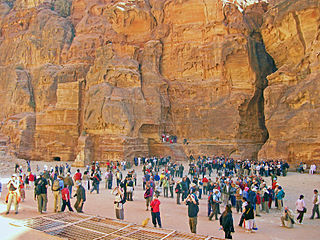
Jordan is a sovereign Arab state in the Middle East. The capital, Amman, is Jordan's most populous city as well as the country's economic, political and cultural centre.
Transport in the Arab League describes the land, air, and water transport methods and infrastructure of the countries in the Arab world. Transport infrastructure in the states of the Arab League has been growing, albeit slowly.
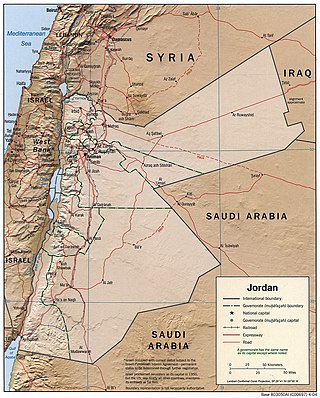
The following outline is provided as an overview of and topical guide to Jordan:
Water supply and sanitation in Jordan is characterized by severe water scarcity, which has been exacerbated by forced immigration as a result of the 1948 Arab–Israeli War, the Six-Day War in 1967, the Gulf War of 1990, the Iraq War of 2003 and the Syrian Civil War since 2011. Jordan is considered one of the ten most water scarce countries in the world. High population growth, the depletion of groundwater reserves and the impacts of climate change are likely to aggravate the situation in the future.
Total: 507 km - narrow gauge of 1,050 mm (2008) Railway companies in Jordan are:
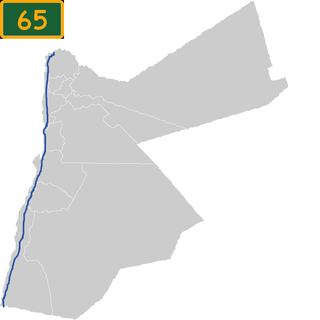
Highway 65, also known as the Dead Sea Highway, is a north–south highway in Jordan. It starts in Aqaba passing through Wadi Araba, and adjacent to the Dead Sea and the Jordan Valley to the western suburbs of the city of Irbid in Jordan's northern tip.

The Hedjaz Jordan Railway is one of the two successor railways to the famous Hedjaz Railway. When the Ottoman Empire collapsed in 1920, the Hedjaz Railway, formerly under Ottoman control, was divided into 2 railways: the Chemin de Fer de Hedjaz Syrie (CFH) and the Hedjaz Jordan Railway (HJR). The HJR operated the line of the Hedjaz railway in Jordan. When Jordan was formed in 1946, the railway served as the state railway of Jordan, though it was not owned by the state. In 1975 the HJR built a line branch line from Ma'an to Aqaba, a port city. The line was later sold to the Aqaba Railway Corporation in 1979. The Hedjaz Jordan Railway still operates today between the Jordan/Syria border, through Amman to Irbid.
The Red Sea–Dead Sea Access is a series of highway construction projects intended to bring easy transportation and prosperity to Jordan, Israel, Palestine and the surrounding area.



















